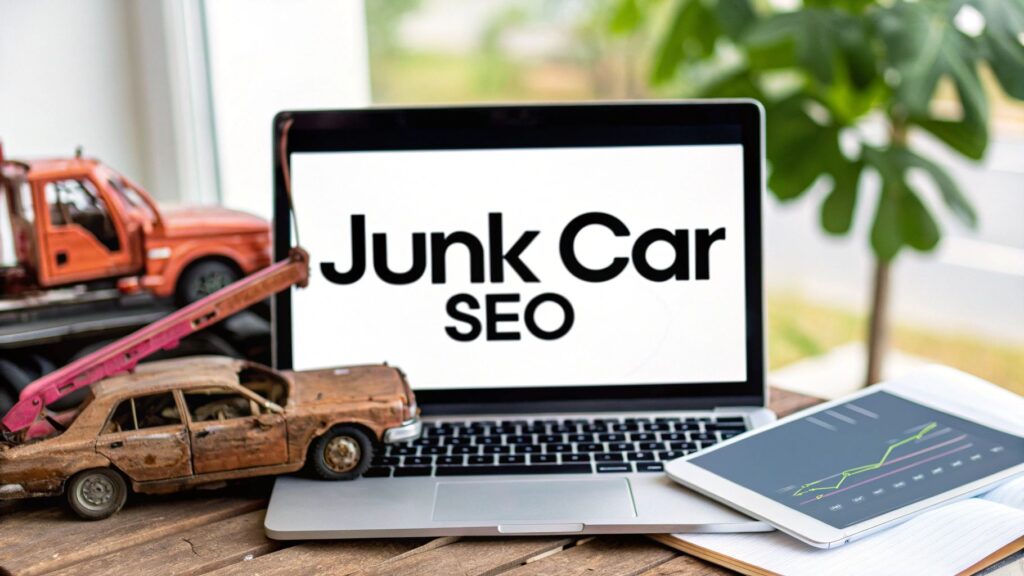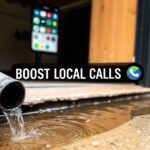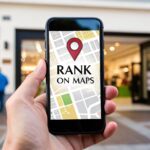You could be the best mechanic in town, but if a driver with a flashing check engine light can't find you online, you're practically invisible. This is where auto repair shop SEO comes in. It’s not about complex tech wizardry; it's about making sure your shop shows up when someone in your area searches for help.
Think of it as your digital welcome mat. It turns frantic "mechanic near me" searches into actual customers pulling into your service bays.
Why Your Auto Shop Is Stuck in Digital Neutral
Being a master with a wrench doesn't automatically make you a star on Google. Many great shops struggle to get noticed online because their customers start their search on a screen, not in a phone book.
The moment that dreaded engine light comes on, what's the first thing people do? They grab their phone. They need a local mechanic, they need them now, and they need to trust them.
The "I Need It Fixed Now" Factor
Nobody leisurely shops for a mechanic weeks in advance. Auto repair is an immediate, urgent need, and it’s almost always local. This is why being at the top of local search results is a must.
The data is clear. In the U.S. alone, Google sees over 60,500 searches for "auto repair" every single month. These are drivers with a real problem who are ready to spend money.
Here’s why that matters for your bottom line:
- 76% of people who search on their phone for a local business visit a physical location within 24 hours.
- That means a potential customer could be walking through your door tomorrow.
You can dig into more local search data for auto shops to see just how powerful this is.
| Local Search Impact on Auto Repair Shops |
| :— | :— |
| Statistic | Why It Matters for Your Shop |
| 60,500+ monthly US searches for "auto repair." | This is a massive pool of potential customers actively looking for your services. |
| 76% of local mobile searchers visit a business within 24 hours. | Your online presence directly translates into foot traffic—and quickly. |
| 46% of all Google searches have "local intent." | Nearly half of all searchers are looking for a local solution, just like you. |
| Local searches lead to a 28% purchase rate. | These aren't just casual queries; they are high-intent searches that convert into sales. |
The takeaway is simple. If you're not showing up on Google Maps and in local search results, you're handing business to your competitors.
In Short: If your shop isn't optimized for local search, you're invisible to most potential customers in your area who are ready to pay for your help right now.
From a Google Search to Your Service Bay
Good auto repair SEO bridges the gap between a driver's search and your shop's open garage door. It’s about sending the right signals to Google so it knows three things about your business:
- What you do: Are you the go-to for brake repair or engine diagnostics?
- Where you are: Is your address and service area clear?
- Why they should trust you: Do you have great reviews and a professional website?
When you get these elements right, you make it easy for Google to connect you with a customer in need. This direct pipeline from search result to your front counter is the foundation of a modern auto shop.
Your Google Business Profile Is Your Digital Front Door
If you do nothing else for your shop's online presence, get your Google Business Profile (GBP) right. Think of it as your digital storefront. It's the first thing people see when they search for a mechanic nearby, and it's free.
A well-managed profile is a trust-building machine. It showcases your expertise and answers questions the moment a customer is looking for help. It's the single most powerful tool you have to turn a "mechanic near me" search into a new customer.
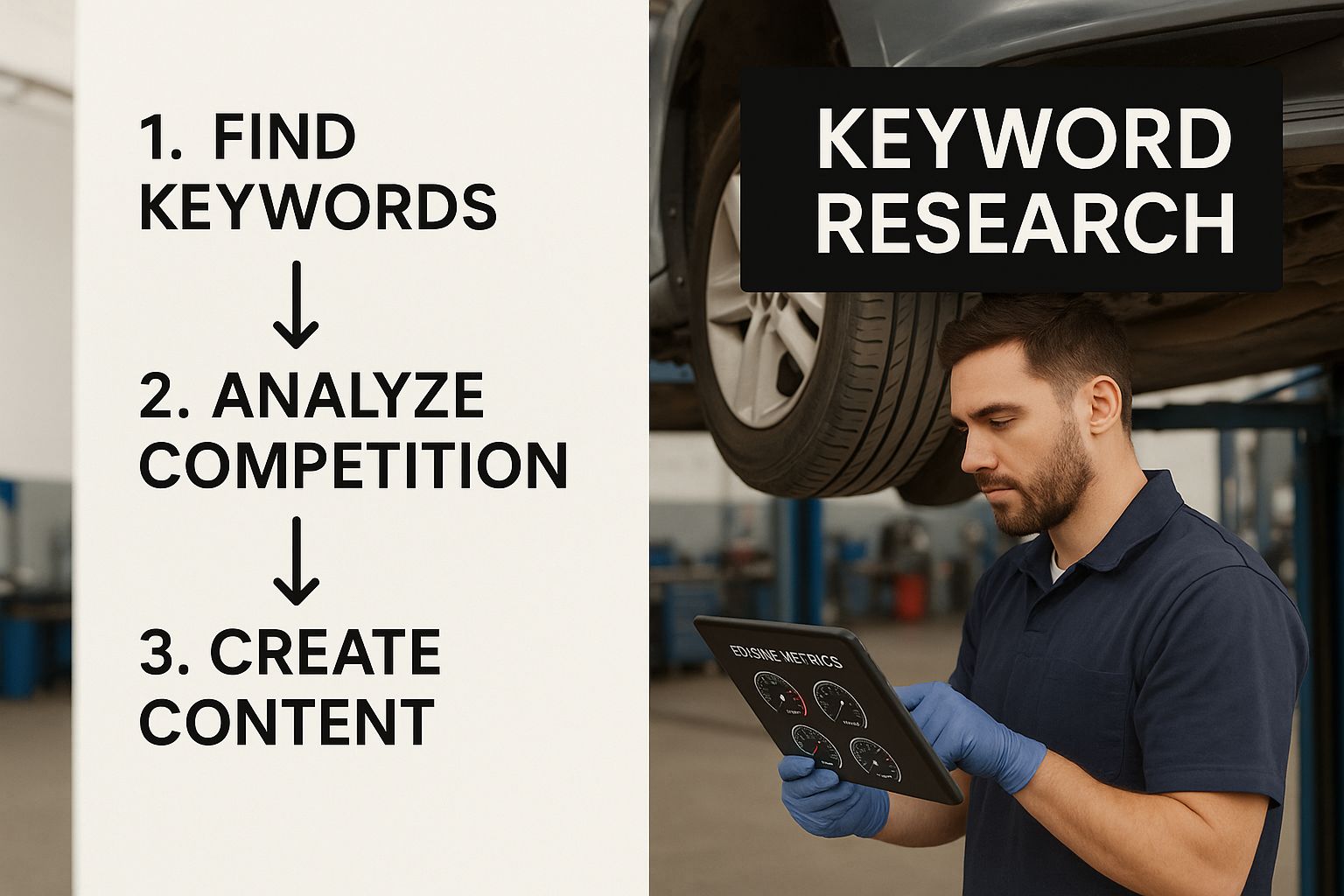
Don't Just Be an "Auto Repair Shop"—Get Specific with Categories
This is a common mistake. A shop owner sets their primary category to "Auto Repair Shop" and stops there. That's a huge missed opportunity. Google lets you add secondary categories, and you absolutely should.
Think about what you really do.
- Are you the go-to for brakes? Add "Brake shop."
- Specialize in transmissions? Add "Transmission shop."
Here are a few more to consider:
- Tire shop
- Oil change station
- Car inspection station
- Muffler shop
- Auto radiator repair service
Getting specific tells Google exactly what you offer, helping you rank for "oil change in Anytown" instead of just a general mechanic search.
Pro Tip: Set your primary category to what best describes your business as a whole. Then, use secondary categories to capture all those niche service searches.
Your Business Description: More Than Just Keywords
You have 750 characters for your business description. This is your elevator pitch, not a keyword list. Write it for a human.
What makes your shop the one they should trust?
- Talk about your years of experience.
- Mention that you're a family-owned business.
- Do you specialize in certain makes like Toyotas or Fords?
- Do you offer a great warranty?
This is your chance to make a personal connection and build trust. A great description answers one simple question: "Why should I pick you over the other guys?"
Show, Don't Just Tell, with Great Photos
Pictures are a big deal. A profile with good photos gets 42% more requests for driving directions. People want to see where they're going and who they're dealing with.
Upload clear, professional-looking photos that build confidence.
- Outside Your Shop: A clean shot of your sign and storefront.
- Inside the Bays: Show off your clean, organized workspace.
- Your Team: Action shots of your mechanics working are fantastic.
- Waiting Area: Make it look clean and welcoming.
- Your Work: Before-and-after photos are very persuasive.
Adding new photos regularly signals to Google that your business is active.
Use Google Posts and Q&A to Stay Active
Google Posts are free mini-ads on your profile. They're perfect for announcing a special, reminding people about seasonal maintenance, or showing off new equipment.
The Q&A section is another goldmine. People can ask questions right on your profile. The trick is to be proactive. Think of the most common questions you get and add them yourself, then answer them.
Here are some real questions users ask:
-
How do I get my auto repair shop to show up on Google Maps?
It starts with claiming and completely filling out your Google Business Profile. From there, add specific categories, great photos, and consistently get good reviews to climb in the local map pack. -
How can I improve my local SEO for my auto shop?
Nail your Google Business Profile first. Then, focus on getting a steady stream of positive reviews. Finally, make sure your shop's name, address, and phone number (NAP) are identical everywhere online. -
What is the best SEO keyword for an auto repair shop?
Target high-intent, long-tail keywords. Think like a customer: "brake repair in [Your City]" or "Honda mechanic in [Your Neighborhood]." These are the searches that turn into jobs.
Actively managing these features shows Google and customers that you're engaged and ready for business. To go deeper on ranking in the map pack, this guide to local maps SEO covers more advanced tactics.
Finding Keywords That Actually Bring Cars into Your Bays
Great auto repair shop SEO isn't about ranking for a vague term like "car repair." It's about showing up when a driver in your town has a problem and is searching for a solution.
You have to think like your customers. Nobody types "automotive solutions" when their car is making a clunking sound. They search for what they hear, see, or think the problem is.
Think Services, Not Just "Repair"
Your most valuable keywords are your services. These are your "money" keywords that signal a customer is ready to buy. Someone searching for "transmission fluid leak repair" has a serious issue they need fixed now.
Start by making a big list of everything you do.
- Brake services: "brake pad replacement," "rotor resurfacing," "fix squeaky brakes."
- Engine work: "check engine light diagnostics," "engine tune-up," "timing belt replacement."
- Tires and alignment: "new tires for sale," "four-wheel alignment," "flat tire repair."
- AC and heating: "car AC recharge service," "heater core repair," "broken car AC."
Each one of these is a direct line to a customer with a specific, urgent need.
Pro Tip: The more specific the search, the more motivated the customer. It's better to rank for "Honda Civic alternator replacement" than the generic term "car mechanic."
Add Vehicle Makes and Models You Know Best
Are you the go-to shop for Ford F-150s? Do your mechanics know BMWs inside and out? Highlighting the makes and models you specialize in is a keyword goldmine.
It's a simple formula: service + car model.
- "Ford Explorer brake repair"
- "Toyota Camry oil change"
- "Chevy Silverado transmission service"
This helps you capture searchers looking for a specialist. They often feel a mechanic who knows their specific vehicle will do a better job.
Don't Forget Location, Location, Location
Now, let's tie it all together with the most critical piece for a local business: your location. This separates random internet searchers from people who can actually drive to your shop.
Take your service and vehicle keywords and add your local identifiers.
- "check engine light diagnostics in Springfield"
- "BMW mechanic downtown Austin"
- "tire alignment shop near O'Hare"
You've just transformed a generic term into a powerful, high-intent phrase. This is the core of effective auto repair shop SEO.
This strategy is key for organic search and any marketing you do. You can dig deeper into how this works when looking at PPC vs. SEO for auto repair shops and see how paid ads can complement these efforts.
Your Website's Job: Turning Clicks Into Customers
Getting people to your website is only half the battle. Your site needs to convince them to book an appointment. Think of it as your digital front office. If it's slow, confusing, or outdated, customers will leave.
Your auto repair shop SEO efforts get them in the door; a great website seals the deal.
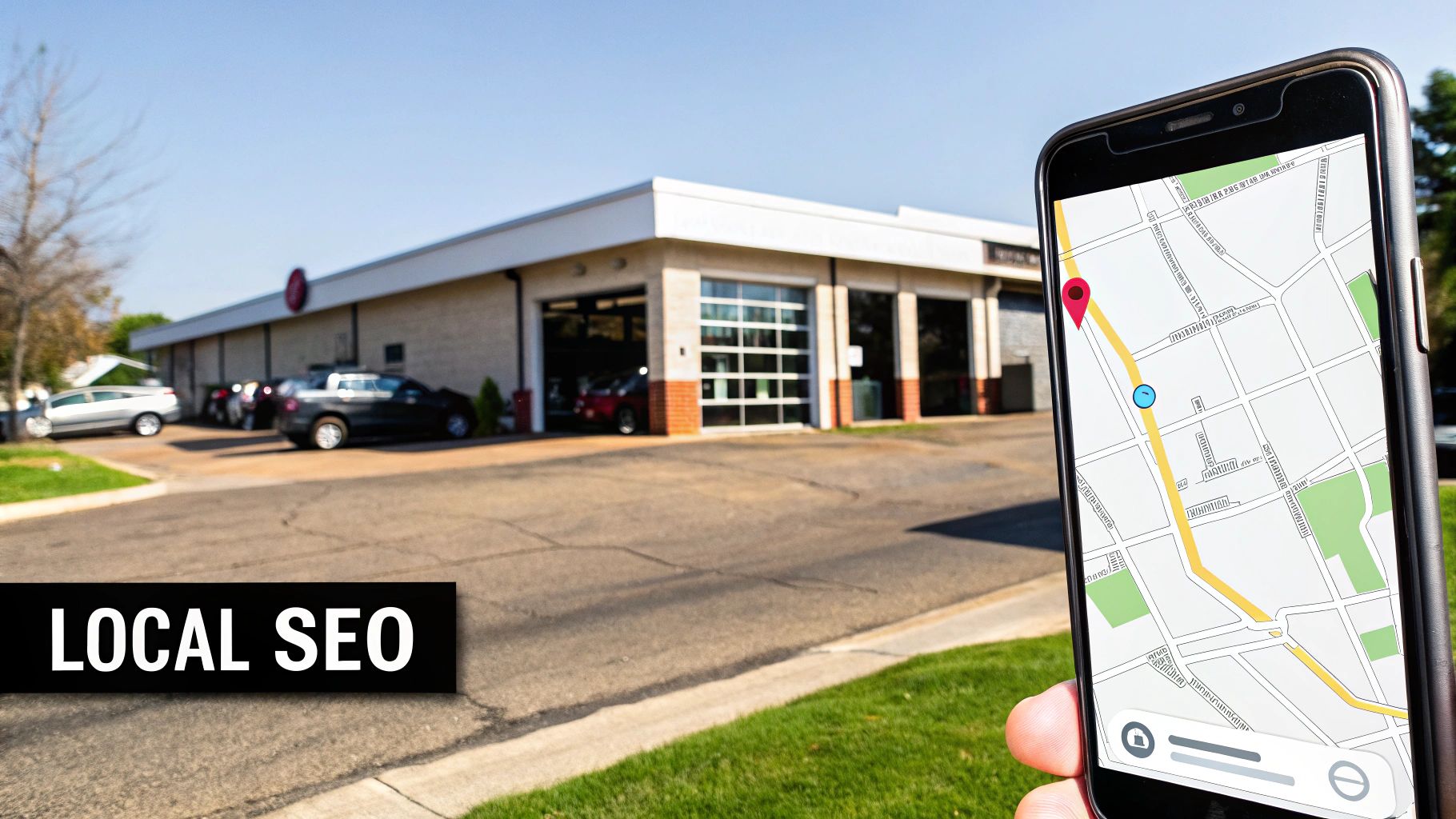
Don't Lump All Your Services Together
This is a common and damaging mistake. Shops create a single "Services" page and list everything they do. That's a huge SEO killer.
Someone searching for "transmission repair" wants a page dedicated entirely to transmission repair, not a generic page that also talks about oil changes.
Give every major service its own dedicated page.
- Brake Repair: Detail the signs of failing brakes and explain your inspection process.
- Engine Diagnostics: Explain what the check engine light means and how you diagnose the problem.
- AC & Heating: Cover everything from simple recharges to full compressor replacements.
- Oil Changes: Explain the different types of oil you offer and why it matters.
This strategy helps you target specific keywords and shows Google (and customers) that you're an authority on that service.
Speed and Mobile-Friendliness Aren't Optional
Most people are looking for a mechanic on their phone, probably while stressed out. If they have to pinch and zoom to find your phone number, you've lost them. Your website must work flawlessly on a smartphone.
It also has to be fast. If your site takes more than a few seconds to load, that customer is calling the next shop on the list.
In Short: A slow, clunky website will kill your conversion rate. A customer won't wait for your page to load—they'll just move on.
Build Trust the Second They Arrive
When a visitor hits your website, they’re looking for reasons to trust you. You have about five seconds to make a good impression.
Here's how to build trust instantly on your homepage:
- Show Off Certifications: Is your shop ASE-certified? Put that logo front and center.
- Display Real Customer Reviews: Feature a few glowing testimonials from happy customers.
- Use Real Photos: Ditch the stock photos. Show pictures of your actual team and service bays.
- Tell Your Story: Have a solid "About Us" page. Are you a family-owned business that's been around for 30 years? Say so!
These elements make a new customer feel like they've made the right choice.
What Are the Core Pieces of On-Page SEO?
On-page SEO boils down to three fundamentals.
- Content: This is the text, images, and videos on your pages. Your content needs to be helpful and directly answer your customers' questions.
- HTML (Title Tags & Meta Descriptions): This is what shows up in Google search results. Your page title and the snippet of text below it need to grab attention and include your main keyword.
- URL Structure: Keep your page URLs clean and descriptive. A URL like
yourshop.com/brake-repairis much better thanyourshop.com/page-id-879.
Nailing these components is the foundation of a website that brings in business and is a key part of any modern auto repair marketing plan.
Earning Trust: Your Reputation is Your Best Marketing
In the auto repair business, trust is everything. A good website might get people to your door, but trust makes them hand over the keys. Your online reputation—built on reviews and consistent local listings—plays a massive role in your shop's SEO.
Their car is a big investment. Customers are looking for proof that you do quality work.
The Real Power of Customer Reviews
Online reviews are the new word-of-mouth. A staggering 93% of people say online reviews influence what they buy. For car repair, that number is even more critical.
Good reviews send a powerful signal to customers and Google that your shop is a top choice. But asking for them can feel awkward. The trick is to make it a natural part of your process.
In Short: Don't just hope for good reviews. Build a simple process to ask for them right after you've delivered fantastic service to a happy customer.
Here’s a simple, non-aggressive way to get more reviews:
- Get Your Google Review Link: Grab the direct link to leave a review on your Google Business Profile.
- Create a QR Code: Use a free online tool to turn that link into a scannable code.
- Put it on Your Invoices: Add the QR code to every invoice with a friendly note like, "Love our work? We'd be grateful for your feedback!"
- Display it at the Counter: Use a small sign or sticker with the QR code at your checkout counter.
This makes it easy for happy customers to leave you a review on their own time.
You Have to Respond to Every Single Review
Getting reviews is only half the battle. Responding shows you're engaged and that you care about what customers think.
- For the Good Ones: A simple, "Thanks, John! We appreciate your business and are glad we could help" works wonders.
- For the Bad Ones: This is where you can stand out. A calm, professional response that addresses the complaint without getting defensive can turn a negative into a positive.
Ignoring a bad review is the worst thing you can do. It silently says, "We don't care."
What Are Local Citations and Why Should I Care?
Local citations are any online mention of your shop's Name, Address, and Phone number (also known as NAP). Think of online directories like Yelp, the Better Business Bureau (BBB), and others.
Google constantly scans the web for information about your shop. When it finds your exact NAP details listed consistently across many reputable sites, it reinforces that you're a legitimate, established business.
But if it finds an old address on one site and your current one on another? That creates confusion and can hurt your local rankings. NAP consistency is a foundational trust signal for Google.
Here are some real questions users ask:
-
How do I get my auto repair shop listed on Google?
It all starts with your free Google Business Profile. Claiming and completely filling out your profile is the single most important thing you can do for your local SEO. -
How can I manage my business reputation online?
Actively encourage customer reviews on platforms like Google. Make it a daily habit to check for new reviews and respond professionally to every single one—good and bad. -
How do I build local citations for my business?
First, lock down the major players: Google, Yelp, and Facebook. Make sure your NAP is perfect there. After that, you can manually submit your info to other directories or use a service to speed up the process.
Tracking What Actually Matters for Your Shop
How do you know if your SEO is actually working? Forget vanity metrics like "impressions" or "clicks." You need to focus on numbers that lead directly to more cars in your bays.
Let's cut through the noise and get straight to the data that impacts your bottom line.
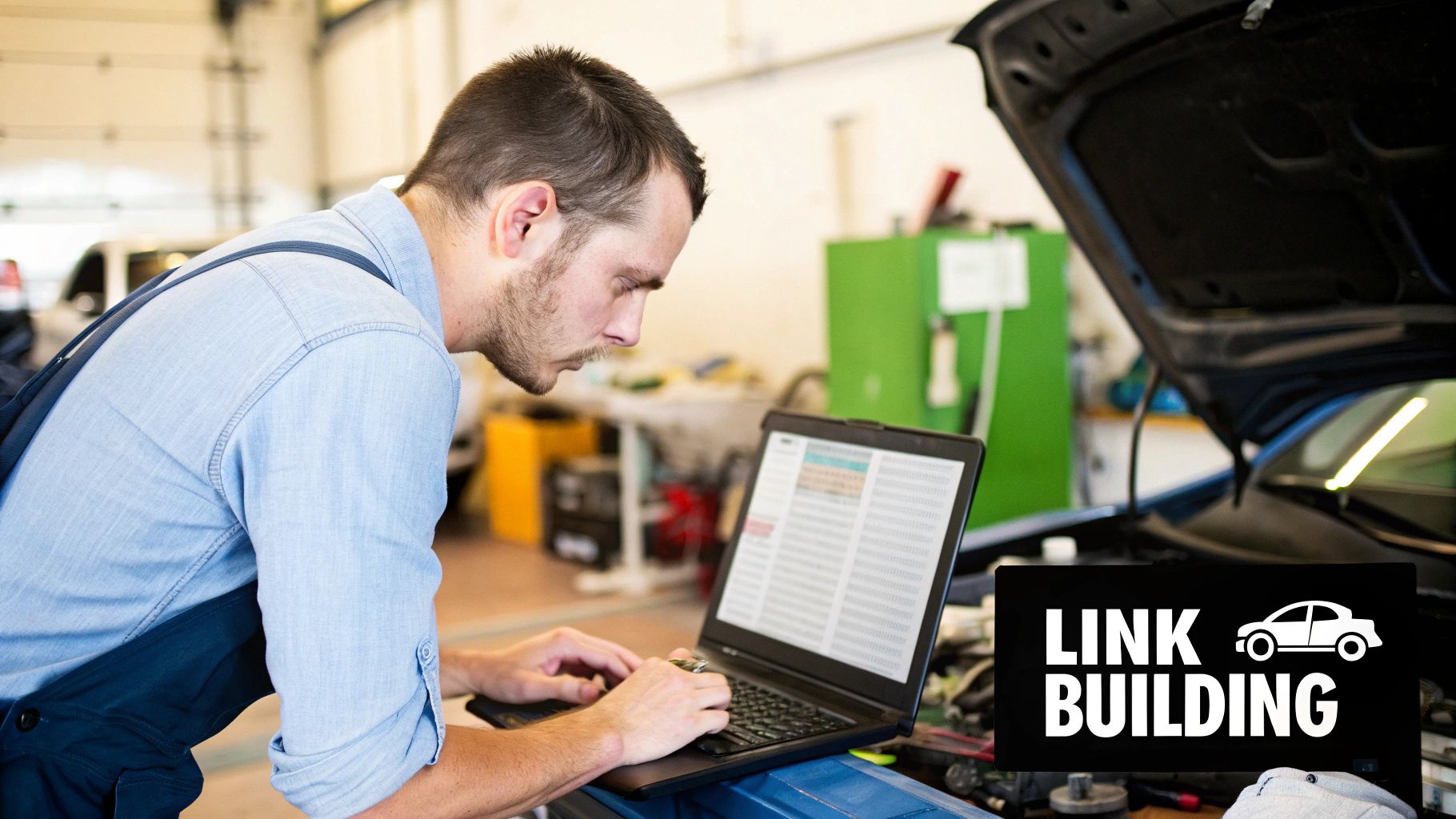
Key Metrics You Should Actually Be Watching
Don't get bogged down in complex spreadsheets. Focus on a handful of key indicators that show real customer interest and business growth. You can track most of this for free with Google's tools.
- Keyword Rankings: Are you showing up for searches like "brake repair in [Your City]"? You can use a tool or an incognito browser window to check where you rank for your most valuable keywords.
- Organic Website Traffic: Go to your Google Analytics account. Are more people finding your site through search? A steady climb is a great sign.
- Google Business Profile Interactions: This is the big one. Your GBP dashboard shows you the real action.
In Short: The real goal is to draw a clear line from your SEO work to an increase in phone calls, quote requests, and scheduled appointments. That's the only ROI that matters.
Your Google Business Profile Is a Goldmine of Data
The "Performance" tab in your Google Business Profile (GBP) is packed with insights. It shows you exactly how people find you and what they do next.
Focus on these three metrics:
- Phone Calls: How many people tapped the "Call" button from your Google listing? That’s a hot lead.
- Website Clicks: How many potential customers went from Google to your website?
- Driving Directions: This is a huge buying signal. Someone requesting directions is likely on their way to your shop.
When you nail your SEO, the results can be huge. We've seen some Canadian auto shops boost their traffic by 103% to 154% by getting these strategies right. Check out these auto body shop SEO case studies to see what's possible.
By watching these simple, powerful metrics, you can connect your online marketing to real, measurable growth.
Common Questions We Hear from Shop Owners
Getting started with SEO can bring up a lot of questions. Here are the straight-up answers to a few we hear all the time.
How Long Until My Phone Actually Starts Ringing?
Let's be realistic. You can see your phone start ringing from your Google Business Profile optimizations in just a few weeks.
But for your website to climb the rankings for big-money keywords? You're typically looking at 3 to 6 months of consistent work. Think of it like building trust—it takes a little time, but it's worth it. Consistency creates a "snowball" effect that leads to serious long-term growth.
Should I Do This SEO Stuff Myself or Hire a Pro?
You can absolutely do a lot of this yourself. If you optimize your Google profile, focus on getting reviews, and make basic website tweaks, you'll be ahead of the competition. It’s a great, budget-friendly way to start.
The time to call an expert is when you run out of time or want to go after highly competitive keywords. A specialized automotive SEO agency can often get you there much faster.
If I Only Do One Thing, What Should It Be?
Hands down, your Google Business Profile (GBP). No question. Think of it as your new digital storefront on the front page of Google.
A well-managed GBP with plenty of great reviews, up-to-date info, and real photos is a customer-generating machine. Many people will find you, read reviews, and call you directly from that listing without ever clicking through to your website. It's the single most powerful tool you have for snagging local customers.
Ready to stop being the best-kept secret in town and start packing your service bays? The team at Clicks Geek builds custom SEO and digital marketing game plans specifically for auto repair shops. We'll handle the online marketing, so you can focus on what you do best. Get your free, no-pressure proposal today.
Is Your Business Ranking in Google Maps?
Turn Google Maps into a Lead Engine w/ Clicks Geek’s AI-powered local SEO. 3,000+ clients served. Our proprietary, fully done-for-you Maps SEO system handles everything—keyword targeting, local optimization, content, reviews, and ranking strategy—automatically.


